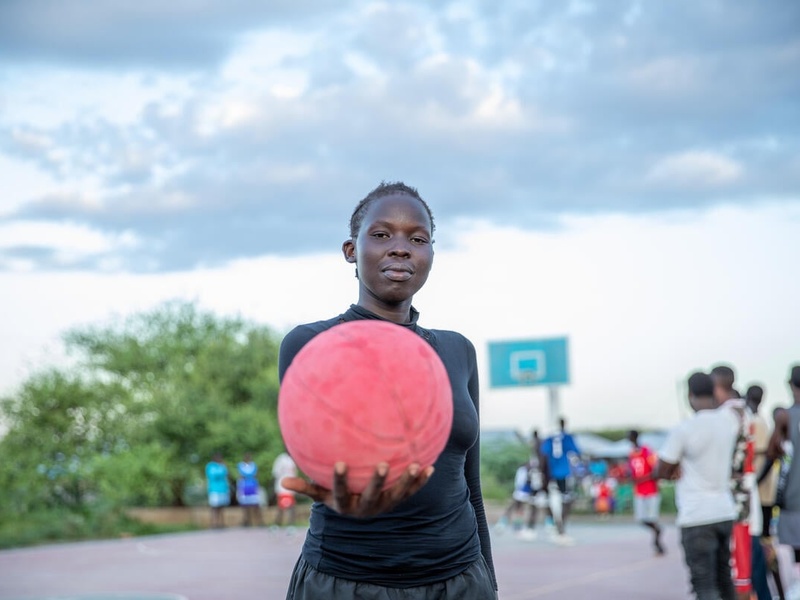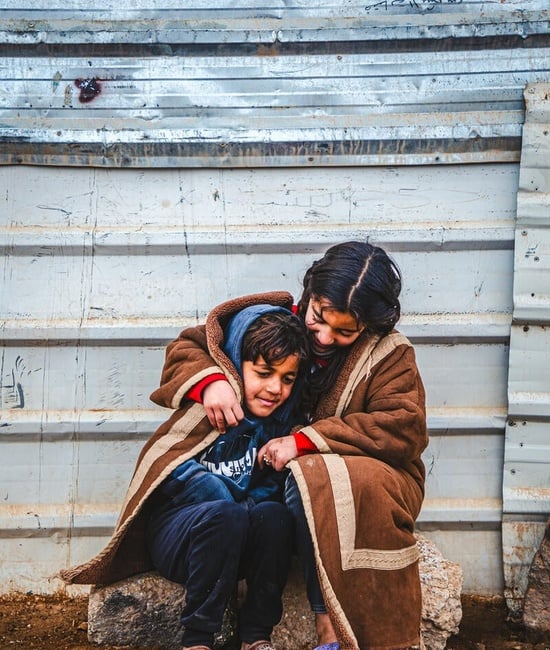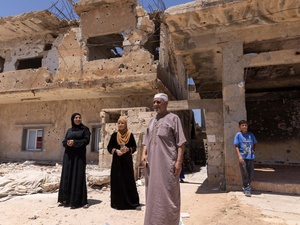Global Trends

Syrian refugees Batool, 9, and her brother Abdulaziz, 7, in the Zaatari refugee camp, Jordan.
Global Trends
Syrian refugees Batool, 9, and her brother Abdulaziz, 7, in the Zaatari refugee camp, Jordan.
At the end of 2024, an estimated 123.2 million people worldwide were forcibly displaced due to persecution, conflict, violence, human rights violations and events seriously disturbing the public order.
This is an increase of 7 million people or 6 per cent compared to the end of 2023. While displacement has almost doubled globally over the last decade, the rate of increase slowed in the second half of 2024. By the end of April 2025, UNHCR estimates that the global number of forcibly displaced people has likely fallen slightly by 1 per cent to 122.1 million, the first decrease in well over a decade.
Whether this trend continues or reverses during the rest of 2025 will largely depend on whether peace or at least a cessation in fighting is possible to achieve, particularly in the Democratic Republic of the Congo, Sudan and Ukraine; whether the situation in South Sudan does not deteriorate further; whether conditions for return improve, in particular in Afghanistan and Syria; and how dire the impact of the current funding cuts will be on the capacity to address forced displacement situations around the world and create conducive conditions for a safe and dignified return.
At the end of 2024, 123.2 million people were forcibly displaced.
This equates to 1 in every 67 people on Earth.
Displacement nearly doubled during the last decade.
The search for peace must be at the heart of all efforts to find long-lasting solutions for refugees and others forced to flee their homes.
People forcibly displaced worldwide | 2015 – 2024
Key displacement situations in 2024
Sudan crisis
The war in Sudan is the world’s largest displacement crisis.
A total of 14.3 million Sudanese people remained displaced at the end of 2024. This was 3.5 million more people than 12 months prior and represents nearly one in three of the national population.
Pictured: Newly arrived Sudanese refugees in the border town of Adre, Chad. © UNHCR/Andrew McConnell
Solutions for forced displacement rose in 2024
Solutions for refugees and internally displaced people all increased during 2024, with refugee returns the highest reported in more than two decades (1.6 million). However, underlying these positive trends with each solution are concerns about the inherent protection risks to forcibly displaced people and the longer-term sustainability of these solutions.
In the past year, 92 per cent of the 1.6 million refugee returns were to only four countries: Afghanistan, Syria, South Sudan and Ukraine. Many Afghan, Syrian and South Sudanese refugees have returned in adverse conditions and arrived in extremely fragile situations. In Ukraine, despite the war entering its fourth year, many vulnerable refugees have chosen to return partly due to challenges in accessing rights and services in host countries. In Afghanistan, returnees have arrived to a country gripped with pervasive poverty, soaring unemployment, severely inadequate public services and widespread food insecurity.
The past year also saw the highest number of refugees resettled to third countries for more than 40 years (188,800). In addition, almost 88,900 refugees obtained their host country’s citizenship or were granted permanent residence in 2024.
More than 8.2 million IDPs also returned to their area of origin in 2024, the second highest total ever recorded. But in the absence of peace and stability in their country, many IDPs remain trapped in cycles of returns followed by new displacement and conflicts are becoming increasingly protracted. Many of these returns therefore may not be sustainable.
Spotlight situations: Three displacement crises in focus
Return to Syria
The fall of the government on 8 December dramatically shifted the dynamics surrounding refugee returns to Syria, with a growing number of refugees living in neighbouring countries expressing a positive intention to return home.
Pictured: Syrian refugees arrive at the Cilvegözü – Bab Al-Hawa border crossing between Türkiye and Syria to complete a voluntary repatriation process before returning home to Syria. © UNHCR/Emrah Gürel
Forcibly displaced populations
Some Palestine refugees under UNRWA’s mandate in Gaza have also been internally displaced. In these figures, they are counted in both the internally displaced people total, and the global total of refugees. However, they are only counted once in total number of displaced people (123.2 million people).
Text and media 4 - Copy
"There is so much talent in the camp. We just need more opportunities to showcase them."
"Basketball is my favorite sport," says Doris, a refugee from South Sudan now living in the Kakuma Refugee Camp in Kenya. "It also keeps youth in the camp away from drugs and for girls it keeps them away from early pregnancies."
A humanitarian system at breaking point
UNHCR and the broader humanitarian community are facing detrimental funding cuts, that will severely impact millions of people globally.
Without sufficient funding, there will not be enough food assistance and basic shelter support for displaced people. Protection services, including safe spaces for refugee women and girls at risk of violence, are likely to be terminated. Communities that have generously hosted forcibly displaced people for years will be left without the support they need. And, perhaps most critically, hopes for returns will either not materialize or the return will not be dignified and will not be accompanied by an increase in adequate services in countries of origin. As a result, people that do return may have no choice but to leave again.
For the number of forcibly displaced people to reduce, meaningful progress is required on the root causes – conflict, disregard for the basic tenets of International Humanitarian Law, other forms of violence and persecution.
In the meantime, resources to meet urgent humanitarian needs, to support host countries, to protect people from the risks of dangerous onward movements and to help refugees and other forcibly displaced people find durable solutions are more essential than ever.
The consequences of inaction will be borne by those who can least afford it.
Without sufficient funding, there will not be enough food assistance and basic shelter support for displaced people.
Download the report and annexes
Text and media 53
Global Trends 2024
UNHCR's Global Trends report presents the latest numbers of refugees, asylum-seekers, internally displaced and stateless persons worldwide.
Download the Global Trends report
Annexes and raw data
About the UNHCR Global Trends and Mid-Year Trends reports
UNHCR releases two flagship statistical reports on global forced displacement each year, the Global Trends report and the Mid-Year Trends report. The Global Trends report, released annually in June, analyses changes and trends in forcibly displaced populations in the previous calendar year (from 1 January to 31 December). It provides key statistics on the global numbers of refugees, asylum-seekers, internally displaced people and stateless people, as well as their main host countries and countries of origin.
In October each year, the Mid-Year Trends report is released to provide updated figures and analysis for the initial six months of the current year (from 1 January to 30 June). These figures are preliminary, and the final data is included in the subsequent Global Trends report.





